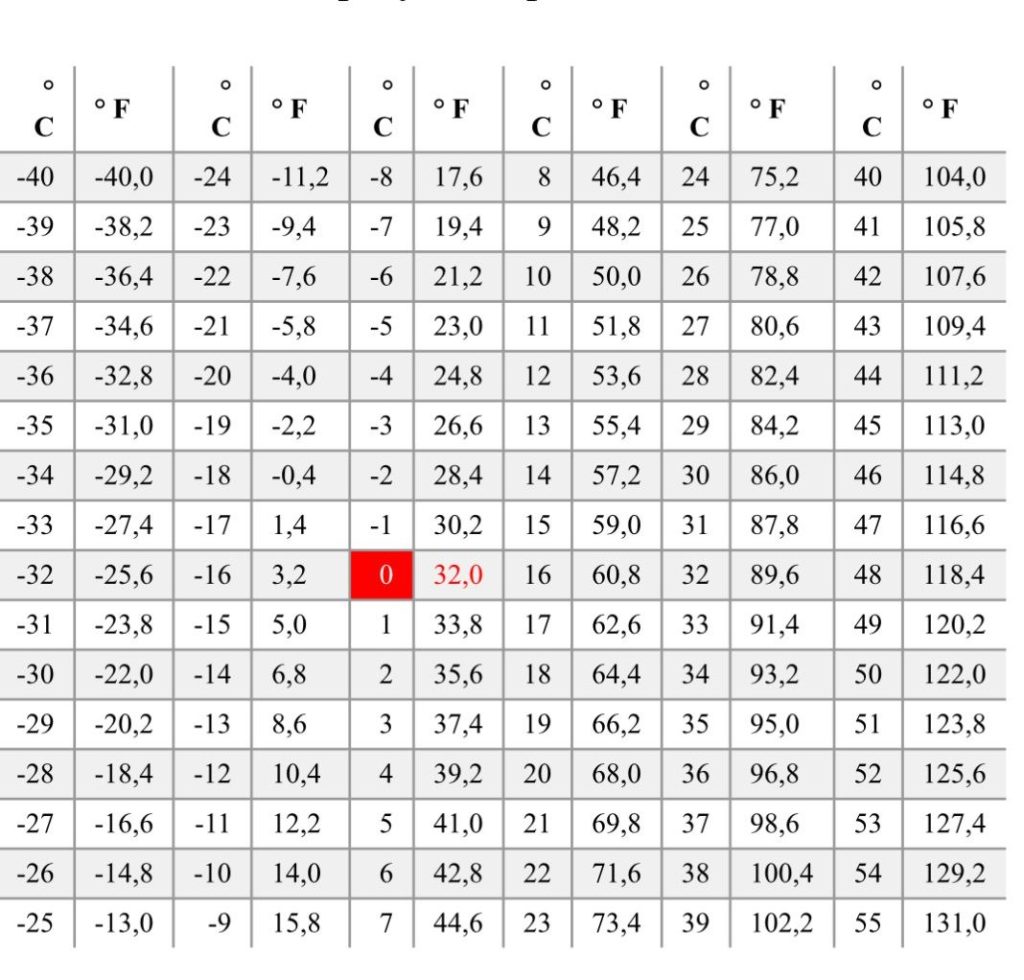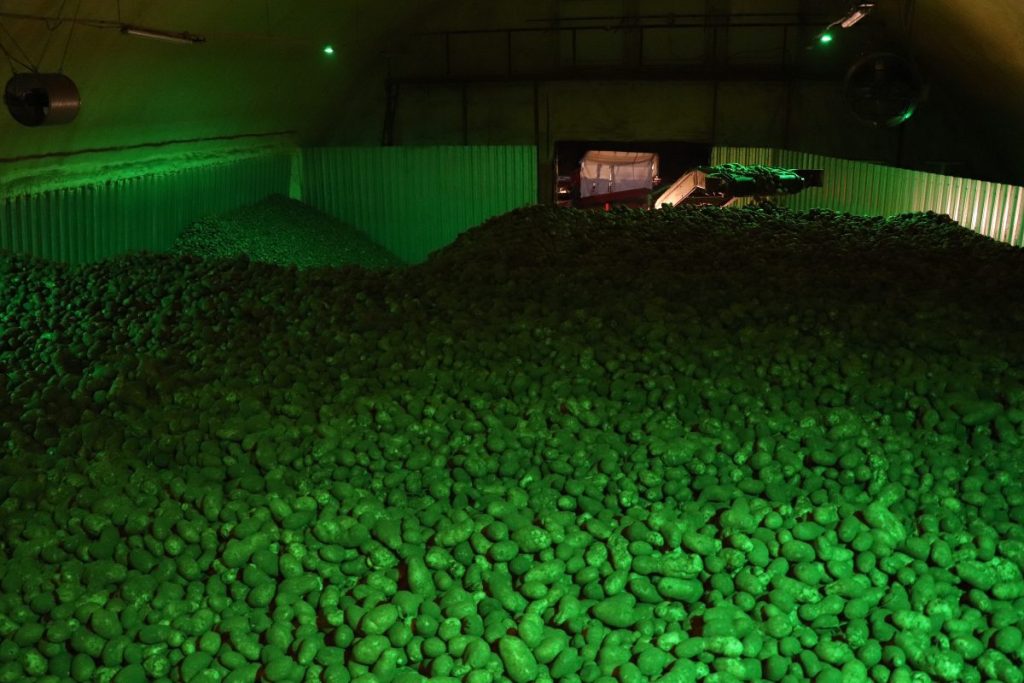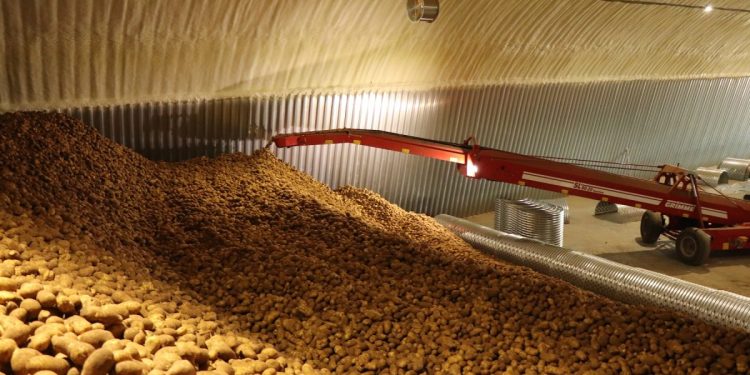The range in environmental conditions during harvest can be vast depending upon daily weatherand time of day. “Ideal” harvest conditions have tuber pulp temperatures between 50 to 55°F.

Realistically, the recommendations are to harvest between 45 and 65°F. Monitoring pulp temperatures and adjusting harvest times during the day may be necessary to fall within that temperature range. This temperature range may need modification if harvesting in a rocky field, growing a susceptible variety, or growing conditions in the field increased crop susceptibility to bruising or disease such as stress, early-die, and over- or under-watering.
Cold pulp temperature consequences:
Avoid harvesting potatoes with pulp temperatures less than 45°F. For varieties susceptible to Fusarium dry rot (for example Clearwater Russet, Umatilla Russet) it is recommended to harvest at pulp temperatures above 50°F. Cold temperatures increase the potential for potatoes to shatter bruise or fissures to occur and thus allow a perfect entry point for Fusarium dry rot or other pathogens to invade. Shatter bruises are also more difficult to wound heal due to the jaggedness of the wound. The damaged surface area of a potato can lose up to 500% more water compared to an undamaged area.
- This can be a significant contribution to overall shrinkage, especially in the early part of the storage season when respiration and transpiration losses are at the highest.
Some varieties, such as Ranger Russet, can lose processing quality quickly if exposed to cold temperatures (<45°F). The increase in reducing sugars due to cold temperature exposure does not ameliorate in storage—the damage is already done.
Towards the end of the harvest season there may not be many warm days left and some potatoes may be going into storage at sub-optimal pulp temperatures. Perhaps those potatoes are the last to be loaded into a cellar that is already holding potatoes harvested at warmer temperatures. Or even more common, potatoes harvested in the morning at colder temperatures and potatoes harvested in the afternoon at warmer temperatures are piled in the same storage. This makes for trickier management decisions. The potential for condensation within the pile and on the surface is greater. Ventilation is key to managing the pile temperature differences.
It is best to bring in air about 1°F-2F less than the coldest potatoes. If the bottom of the pile is not at least 50°F, it is recommended to slowly allow the pile to warm up, yet still provide maximum fresh air. This will provide more favorable conditions for wound healing to occur. The heat load in the storage is high at harvest – 30+ BTU/cwt/day – so there is plenty of heat being generated to warm the pile.
Warm pulp temperature consequences:
There are several major consequences to harvesting warm tubers. First, probability of losses due to pink rot and Pythium leak increases substantially. Pulp temperatures above 65 to 70°F dramatically increase the chance for potatoes to become infected with Pythium even without major wounding. Ideally, it is best to harvest potatoes with pulp temperatures below 65°F to minimize the potential for tuber decay due to Pythium leak.
Although pink rot does not need a wound to infect and decay a tuber, the chance for infection increases dramatically as the tuber is wounded, especially at pulp temperatures above 60°F. Even if you are gently handling your potatoes, pulp temperatures of 70°F increase the risk of pink rot development tremendously if the inoculum is present. Factor in this risk when harvesting at high pulp temperatures.

As just stated, there is a tremendous amount of heat being generated by potatoes at harvest. If tuber pulp temperatures are already high, and the heat of respiration is high, this highlights the number one storage management objective – remove that heat as quickly as possible. There may
not be adequate cooling air available to get control of this heat load. Refrigeration is a great option to cool potatoes at harvest, although the system must have the capacity to handle the high heat load and fresh air also must be provided to purge carbon dioxide out of the building.
If using outside cooling air only, maximize run time by bringing fresh air in 1 to 2°F lower than the coolest potatoes and continue with this step down process until you reach the desired curing temperature. Some computerized control panels can be programmed to do this whereas others you may have to manually reset each step down in temperature. Do not simply set the set point to 55°F – this will not maximize run time. The longer potatoes are above 55°F in storage, the greater the risk for disease breakdown. Ventilation is critical to getting control of the heat load in storage.
Ventilation system – proper lateral duct alignment:
Each storage ventilation system is designed to provide the desired volume and rate of air to the bulk potatoes. Proper air distribution is essential to handle the temperature and disease concerns as described above. Any change in this sophisticated air distribution design will compromise condensation and localized convection management and temperature equilibration of the pile. The aboveground duct pipe must be properly aligned, connected, and sealed to deliver the air as
needed. Gaping holes and misaligned ducts will not provide the air to the pile as designed nor desired. Ensuring this system is properly aligned is a “must” to start the storage season.

